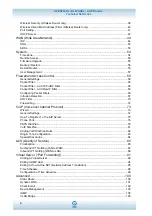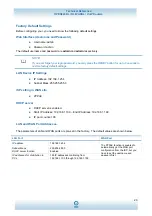
OPEN824RL / RLW ADSL / VoIP Routers
Technical Reference
6
Network Address Translation (NAT)
Allows multi-users to access outside resources such as the Internet simultaneously with one IP address/one
Internet access account. Many application layer gateway (ALG) are supported such as web browser, ICQ,
FTP, Telnet, E-mail, News, Net2phone, Ping, NetMeeting, IP phone and others.
SOHO Firewall Security with DoS and SPI
Along with the built-in NAT natural firewall feature, the router also provides advanced hacker pattern-filtering
protection. It can automatically detect and block Denial of Service (DoS) attacks. The router is built with
Stateful Packet Inspection (SPI) to determine if a data packet is allowed through the firewall to the private
LAN.
Domain Name System (DNS) relay
Provides an easy way to map the domain name (a friendly name for users such as www.yahoo.com) and IP
address. When a local machine sets its DNS server with this router’s IP address, every DNS conversion
request packet from the PC to this router will be forwarded to the real DNS in the outside network.
Dynamic Domain Name System (DDNS)
The Dynamic DNS service allows you to alias a dynamic IP address to a static hostname. This dynamic IP
address is the WAN IP address. For example, to use the service, you must first apply for an account from a
DDNS service like http://www.dyndns.org/. More than 5 DDNS servers are supported.
Quality of Service (QoS) QoS gives you full control over which types of outgoing data traffic
should be given priority by the router, ensuring important data like gaming packets, customer information, or
management information move through the router ay lightning speed, even under heavy load. The QoS
features are configurable by source IP address, destination IP address, protocol, and port. You can throttle the
speed at which different types of outgoing data pass through the router, to ensure P2P users don’t saturate
upload bandwidth, or office browsing doesn’t bring client web serving to a halt. In addition, or alternatively, you
can simply change the priority of different types of upload data and let the router sort out the actual speeds.
Virtual Server (“port forwarding”)
Users can specify some services to be visible from outside users. The router can detect incoming service
requests and forward either a single port or a range of ports to the specific local computer to handle it. For
example, a user can assign a PC in the LAN acting as a WEB server inside and expose it to the outside
network. Outside users can browse inside web servers directly while it is protected by NAT. A DMZ host
setting is also provided to a local computer exposed to the outside network, Internet.
Rich Packet Filtering
Not only filters the packet based on IP address, but also based on Port numbers. It will filter packets from and
to the Internet, and also provides a higher level of security control.
Dynamic Host Configuration Protocol (DHCP) client and server
In the WAN site, the DHCP client can get an IP address from the Internet Service Provider (ISP) automatically.
In the LAN site, the DHCP server can allocate a range of client IP addresses and distribute them including IP
address, subnet mask as well as DNS IP address to local computers. It provides an easy way to manage the
local IP network.
Static and RIP1/2 Routing
Supports an easy static routing table or RIP1/2 routing protocol to support routing capability.
Simple Network Management Protocol (SNMP)
It is an easy way to remotely manage the router via SNMP.
Web based GUI
Supports web based GUI for configuration and management. It is user-friendly and comes with on-line help. It
also supports remote management capability for remote users to configure and manage this product.
Firmware Upgradeable
Device can be upgraded to the latest firmware through the WEB based GUI.
Rich management interfaces
Supports flexible management interfaces. Users can use Telnet, WEB GUI, and SNMP through LAN or WAN
ports to configure and manage the device.








































